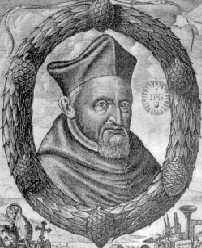St. Robert Bellarmine – September 17
Once again, the feast of St. Robert Bellarmine is upon us. Last year, Randy wrote a post about Bellarmine’s life and contributions. This year, I thought it would be interesting to hear what a few Jesuits might have to say about him. I wrote to several schools and other institutions named after Robert Bellarmine and to the Jesuit communities at several Jesuit universities. I received responses from people at many of them. Not all had comments they wanted to share, but these men did. I offer their responses in order received, with my thanks to all those who took the time to respond.
From Alan Yost, SJ – Formerly of Bellarmine Preparatory School in Tacoma, now working in a parish in Yakima, WA.
I don’t necessarily WANT people to know this about Roberto Belarmino, but since it’s true, and in a spirit of transparency, he was one of the main protagonists in the whole Galileo affair, arguing for the Church and against Galileo regarding the earth-centered vs. sun-centered model of the universe. In retrospect, it’s a little embarrassing, but we have to remember that he was a man of his time and that he was ardent in defending his beliefs and the beliefs of the Church at the time. Recall that Pope John Paul II offered a public apology to Galileo about 400 years after the fact.
From Rev. Clyde F. Crews – University Historian, Bellarmine University
We have had as our university motto, from the very beginning of this institution, the words taken from the introit of the Feast of St. Robert Bellarmine: In Veritatis Amore. To be truly engaged “in the love of truth” in all its dimensions, joys, tasks, and responsibilities remains a central part of our mission. We are also struck by the fact that St. Robert was widely known – in the context of his times – for his tolerance, fairness, kindness, and generosity – especially to those in need.
From Fred Mayovsky, SJ – Math teacher at Bellarmine Preparatory School in Tacoma
St. Robert Bellarmine defended Galileo. OK, Bellarmine was the Pope’s man, but he handled GG with love and gentleness, guiding him (GG) as he (SRB) was telling him what he (GG) could and could NOT state. SRB was a dove and not a hawk in bringing the Pope’s directives. In that same vein, when I teach math and demand neatness and organized thought, I will explain HOW to do the homework and not merely expect my students to do what I “expect” but as I “direct”, so that they assimilate knowledge.
Yes, my reflections on Bellarmine, I teach at a school named after him, I teach in a spirit of which I think he would approve. Sorry I do not have the time to ground and defend my reflections. But they are MY reflections on a great man, and I have been trying to live by his spirit in HIS school.
From James Flaherty, SJ Rector of the Jesuit Community at Marquette University
Bellarmine was probably the most important theologian of the Counter-Reformation era. You might check out the website of the Singapore Jesuits for further info. Just google them and look for their hagiographies on Jesuit saints.
My thanks to each of you for the insights you’ve shared. May the Lord richly bless your ministries.
Read More











